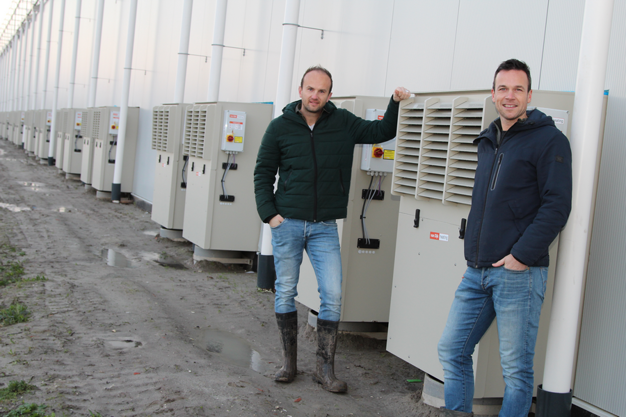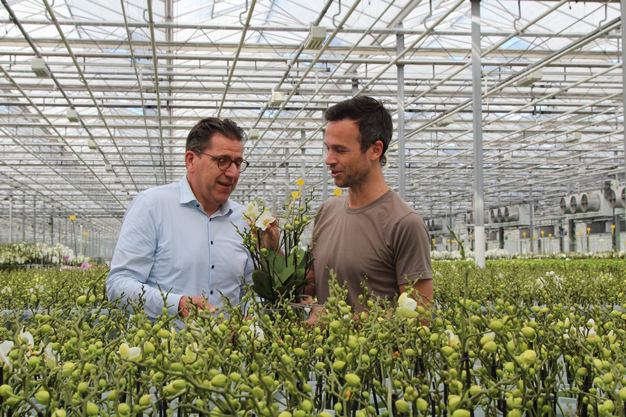Greenhouse construction company Certhon is working hard on a new 3.3-hectare greenhouse for Phalaenopsis nursery Opti-flor in Monster, The Netherlands. Half of the greenhouse is dedicated to the warm cultivation phase, which operates at 28°C. Numerous measures have been implemented to combine perfect growing conditions with limited heat input, with active ventilation from Van Dijk Heating's AVS system playing a key role.
The design of the new greenhouse was carefully considered, as Phalaenopsis is an energy-hungry crop, and energy costs are currently high. Until 2027, when the new cultivation site is set to connect to the Vogelaar geothermal heat source, a combined heat and power system will provide the necessary high-grade heat.
"With a combination of geothermal energy, heat pumps, and heat/cold storage in aquifers, we can sustainably meet our heating needs," explains Rens van Antwerpen of Opti-flor. As a cultivation and energy manager, he has extensive experience with technological innovation, in which the company is once again pushing boundaries. "In the warm section, additional heating capacity is needed to boost low-grade heat efficiently to 28°C greenhouse temperature. We also need efficient air circulation, evaporation, and dehumidification, especially under closed screens."
Ultra-high-spec greenhouse
The roof features Geysir high-diffusing (45% hortiscatter), low-e AR glass (Geysir) topped with a movable external screen for summer cooling and shading. The external walls are made of insulating sandwich panels. Beneath the roof are three movable energy-saving and blackout screens.
"The greenhouse itself is fairly straightforward, but very well equipped," Van Antwerpen adds. "The vents are fitted with insect screens. This also calls for a high capacity for internal recirculation and ventilation via the AVS units. We now have 36 of these along the external walls for an area of 1.5 hectares."
 Jim van Zeijl (left) and Rens van Antwerpen near one of the 36 AVS units that are crucial for efficient climate control in Opti-flor's newest greenhouse complex
Jim van Zeijl (left) and Rens van Antwerpen near one of the 36 AVS units that are crucial for efficient climate control in Opti-flor's newest greenhouse complex
Air movement reaches a maximum of 16.8 m³/m²/hour, with an input of up to 7.5 m³/m²/hour. "We deliberately opted for a higher capacity than in our R&D greenhouse, which also has AVS units. They perform well, but we've set the bar higher for ourselves, and it's also more efficient not to run the system at full power. This keeps us flexible and in control in all situations."
Extensive discussions and calculations
Such a complex setup and ambitious goals required extensive discussions and calculations. The greenhouse construction company, the client, and AVS supplier Van Dijk Heating worked closely together on this.
"These projects are exciting because of their sheer complexity," says Joek van der Zeeuw, who was involved on behalf of Van Dijk Heating. "They really allow you to showcase your capabilities. Rens set out his priorities and limits in terms of control very clearly. The AVS system was dimensioned based on those."
Rapid drying
A key requirement was that the crop should dry quickly after watering. As the pipe heating basically only addresses the need for upward draught and moist absorption, drying and dehumidification are handled by the AVS units. This is primarily achieved through internal air circulation. When needed, drier and cooler outside air is mixed in and brought up to greenhouse temperature inside the units. The fans and air distribution hoses do the rest.
 Before construction began, Van Antwerpen explained the relationship between climate control and product quality to Certhon CEO John van der Sande
Before construction began, Van Antwerpen explained the relationship between climate control and product quality to Certhon CEO John van der Sande
Cascade heating
The heating system is designed through cascade control. "This results in high energy efficiency through maximum cooling of the heating water," explains Jim van Zeijl on behalf of Certhon. "The tube heating system is divided into an upper and lower network. The upper network is fed with high-grade heat. The mixing groups are equipped with an additional mixing valve, allowing the return water from the upper grid to be used for the lower grid. The same principle is applied to the AVS system; return water from the lower network is used as a supply for the AVS cabinets resulting in a lower return temperature in the transport pipeline circuit. If necessary, hot water is first added to bring the air up to greenhouse temperature. In this way, you achieve the greatest possible cooling down of the supplied geothermal heat.
"This system requires precise control of the valve positions and the fan speed of the AVS units," adds Van der Zeeuw. "We use standard Modbus protocols for this, which are both accurate and reliable."
Getting started
Early August 2025 the new greenhouse will be ready for use. Until then, it is a work in progress for Certhon and other contractors. "The builders are having a tough time with all the bad weather, but they're doing a great job," Van Antwerpen manager says. "It's a privilege to work in such an amazing greenhouse and hopefully push a few more boundaries. It will never be perfect, but so far we've managed to make progress in every new greenhouse. I'm confident that will happen in this one too."
For more information:
Van Dijk heating
+31(0)30 656 38 44
[email protected]
www.vandijkheating.com










